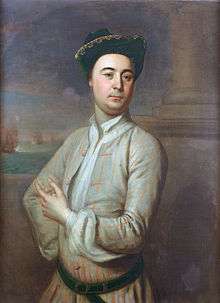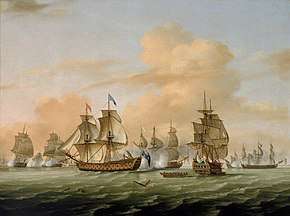Sir Robert Harland, 1st Baronet
Admiral Sir Robert Harland, 1st Baronet (ca. 1715 – 21 February 1784) was a Royal Navy officer. He commanded HMS Tilbury at the Second Battle of Cape Finisterre in October 1747 during the War of the Austrian Succession and commanded HMS Princess Louisa at the Battle of Lagos in August 1759 during the Seven Years' War. He went on to be Commander-in-Chief of the East Indies Station and then First Naval Lord.
Sir Robert Harland | |
|---|---|
 Admiral Sir Robert Harland | |
| Born | ca. 1715 |
| Died | 21 February 1784 |
| Allegiance | |
| Service/ | |
| Years of service | 1729–1783 |
| Rank | Admiral |
| Commands held | HMS Scipio HMS Tilbury HMS Nottingham HMS Monarch HMS Essex HMS Conqueror HMS Princess Louisa East Indies Station |
| Battles/wars | War of the Austrian Succession Seven Years' War |
Naval career

Born the son of Captain Robert Harland, Harland joined the Royal Navy in 1729 when he was appointed a Volunteer-per-order on HMS Falkland.[1] He was present as a lieutenant on HMS Princessa at the Battle of Toulon on 11 February 1744.[1] He was given command of the fireship HMS Scipio in 1745 and, with promotion to post captain on 19 March 1746, he took command of HMS Tilbury and took part in Second Battle of Cape Finisterre on 14 October 1747.[1] He was then appointed to HMS Nottingham later that year and the following year had a major role in the capture of the French 74 gun Magnanime on 31 January 1748.[1][2] He commanded HMS Monarch from 1748 and HMS Essex from 1755 before transferring to HMS Conqueror in 1758.[1] In 1759 he transferred to HMS Princess Louisa and took part in the Battle of Lagos on 18 August 1759.[1]
Harland was promoted to rear-admiral on 18 October 1770 and appointed Commander-in-Chief of the East Indies Station in 1771 remaining there until 1775.[1] He was appointed a baronet on 19 March 1771.[3] He was further promoted to vice-admiral on 5 February 1776[4] before becoming second in command of the Channel Fleet and fighting at the Battle of Ushant on 27 July 1778.[1]
Harland was appointed to the Board of Admiralty in the Second Rockingham ministry in April 1782.[5] He served as First Naval Lord from 1 April 1782, with the rank of full admiral from 8 April 1782,[6] until he left on 30 January 1783.[7] He died at his home in Sproughton in Suffolk on 21 February 1784.[1]
Family
In 1749 he married Susanna Reynold; they had three daughters and a son.[8]
References
- "Sir Robert Harland, 1st Baronet". Oxford Dictionary of National Biography. Retrieved 23 July 2017.
- "Gentleman's Magazine and Historical Review, Volume 18". The Gentleman's Magazine: 136. March 1748.
- "No. 11127". The London Gazette. 16 March 1771. p. 2.
- "No. 11637". The London Gazette. 3 February 1776. p. 2.
- "Sainty, JC, Lord High Admiral and Commissioners of the Admiralty 1660-1870, Office-Holders in Modern Britain: Volume 4: Admiralty Officials 1660-1870 (1975), pp. 18-31". Retrieved 4 September 2009.
- "No. 12286". The London Gazette. 9 April 1782. p. 2.
- Rodger, p. 69
- The Peerage.com
Sources
- Cock, Randolph (2004). "Sir Robert Harland, 1st Baronet". Oxford Dictionary of National Biography. Oxford University Press.
- Laughton, John Knox (1890). . In Stephen, Leslie; Lee, Sidney (eds.). Dictionary of National Biography. 24. London: Smith, Elder & Co.
- Rodger, N.A.M. (1979). The Admiralty. Offices of State. Lavenham: T. Dalton Ltd. ISBN 0900963948.
| Military offices | ||
|---|---|---|
| Preceded by John Lindsay |
Commander-in-Chief, East Indies Station 1771–1775 |
Succeeded by Edward Hughes |
| Preceded by George Darby |
First Naval Lord 1782–1783 |
Succeeded by Hugh Pigot |
| Baronetage of Great Britain | ||
| New creation | Baronet (of Sproughton) 1771–1784 |
Succeeded by Robert Harland |